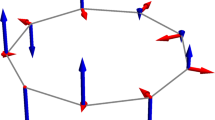Abstract
For two-dimensional uniformly frustratedXY models the group of symmetry spontaneously broken in the ground state is a cross product of the group of two-dimensional rotations by some discrete group of finite order. Different possibilities of phase transitions in such systems are investigated. The transition to the Coulomb gas with noninteger charges is widely used when analyzing the properties of relevant topological excitations. The number of these excitations includes not only domain walls and traditional (integer) vortices, but also vortices with a fractional number of circulation quanta which are to be localized at bends and intersections of domain walls. The types of possible phase transitions prove to be dependent on their relative sequence: in the case the vanishing of domain wall free energy occurs earlier (at increasing temperature) than the dissociation of pairs of ordinary vortices, the second phase transition is to be associated with dissociation of pairs of fractional vortices. The general statements are illustrated with a number of examples.
Similar content being viewed by others
References
S. E. Korshunov and G. V. Uimin, previous paper of this issue.
S. Teitel and C. Jayaprakash,Phys. Rev. B27:598 (1983).
S. Teitel and C. Jayaprakash,Phys. Rev. Lett. 51:1999 (1983).
W. Y. Shih and D. Stroud,Phys. Rev. B28:6575 (1983).
W. Y. Shih and D. Stroud,Phys. Rev. B30:6774 (1984);B32:158 (1985).
V. L. Berezinskii, Thesis (L. D. Landau Institute for Theoretical Physics, Moscow, 1971, unpublished).
J. Villain,J. Physique 36:581 (1975).
E. Fradkin, B. A. Huberman, and S. H. Shenker,Phys. Rev. B18:4789 (1978).
J. Villain,J. Phys. C 10:1717 (1977).
J. Villain,J. Phys. C 10:4793 (1977).
Z. Tešanovič,Phys. Lett. 100A:158 (1984).
G. E. Volovik and M. M. Salomaa,Zh. Eksp. Teor. Fiz. 87:1656 (1985);Phys. Rev. Lett. 55:1184 (1985).
S. Miyashita and J. Shiba,J. Phys. Soc. Jap. 53:1145 (1984).
F. Y. Wu and K. Y. Lin,J. Phys. C 7:L181 (1974).
H. J. F. Knops,J. Phys. A 8:1508 (1975).
S. E. Ashley,J. Phys. A 11:2015 (1978).
R. J. Baxter,J. Phys. A 13:L61 (1980).
J. M. Kosterlitz and D. J. Thouless,J. Phys. C 6:1181 (1973).
Author information
Authors and Affiliations
Rights and permissions
About this article
Cite this article
Korshunov, S.E. Phase transitions in two-dimensional uniformly frustratedXY models. II. General scheme. J Stat Phys 43, 17–32 (1986). https://doi.org/10.1007/BF01010570
Received:
Issue Date:
DOI: https://doi.org/10.1007/BF01010570




